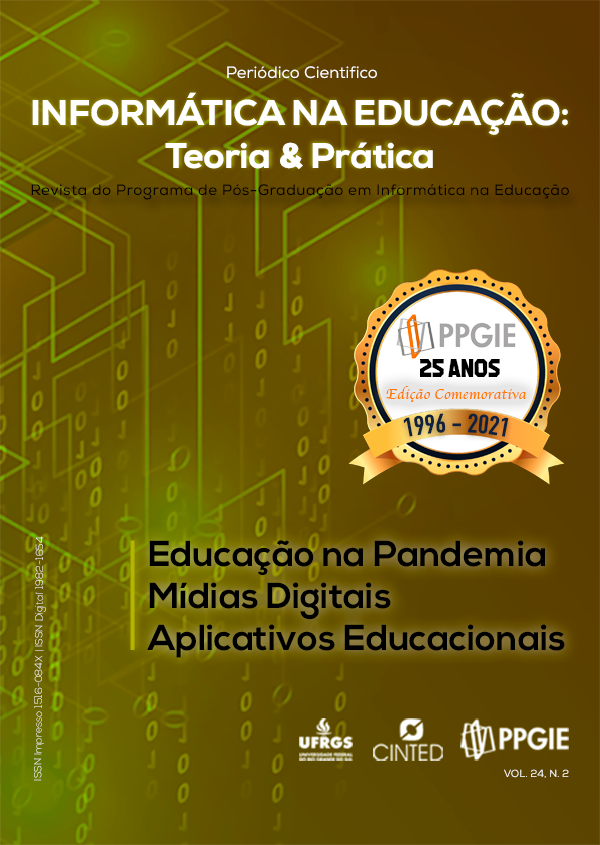Co-Participation and Co-Creation in Higher Education: the use of ICT in the interdisciplinary project “Voz Delas”
DOI:
https://doi.org/10.22456/1982-1654.113798Palavras-chave:
Digital Convergence, Colaborative Learning, Comunication and Information Tecnologies.Resumo
Implementing ICTs in the educational environment is one of the greatest challenges related to pedagogical and technological innovation, since their use can influence how to teach, constituting educational resources. The aim of this article is describe one teaching experience, based on colaborative learning through co-participation and co-creation, that used a lot of resources and digital plattaforms in an undergraduate course. The stages of the construction of co-creation and co-participation took place in four phases. The project lasted 4 months and was developed by 40 students. In conclusion, the introduction of ICTs and virtual learning environments into the traditional teaching model can improve interaction in the teaching-learning process. The activities developed show the possibilities of the use of ICTs as a potential for co-participation and co-creation. The contact with students through the virtual environment created different possibilities to enrich their knowledge.Downloads
Referências
BERNERS-LEE, Tim. The World Wide Web: past, present and future. 1996. Disponível em: <http://www.w3.org/People/Berners-Lee/1996/ppf.html>. Acesso em: 22 jul. 2020.
CASTELLS, Manuel. A sociedade em rede. Rio de Janeiro: Paz & Terra, 1999.
DILLENBOURG, P. What do you mean by "collaborative learning"? In: Collaborative learning: cognitive an computational approaches. Oxford: Elsevier. p. 1-19. 1999.
DOWNES, S. What connectivism is. 2007. Disponível em: <http://halfanhour.blogspot.com/2007/02/what-connectivism-is.html>. Acesso em: 22 jul. 2020.
DUKE, Betsy. HARPER, Ginger. JOHNSTON, Mark. Connectivism as a Digital Age Learning Theory. The International HETL Review, Special Issue, 2013.
FIGUEIREDO, A. D. AFONSO, A. P. Managing learning in virtual settings: the role of context. Coimbra: Universidade de Coimbra, 2006.
GATTI, Bernardete Angelina. A construção da pesquisa em educação no Brasil. Brasília: Plano, 2002.
HALMANN, Adriane; PRETTO, Nelson. Bordas de nuvens: episteme emergente na produção e difusão do conhecimento na web 2.0. Epistemologia, construção e difusão do conhecimento. Perspectivas em Ação. Salvador: EDUNEB, p. 219-248, 2011.
LÉVY, Pierre. Cibercultura. São Paulo: Editora 34, 2000.
MATTAR, João. Constructivism and connectivism in education technology: active, situated, authentic, experiential, and anchored learning. RIED. Revista Iberoamericana de Educación a Distancia. Madri, v.21, n.2, p. 201-217, 2018.
MAURER, A. M et al. Yes, We also Can! O Desenvolvimento de Iniciativas de Consumo Colaborativo no Brasil. In: ENCONTRO DA ANPAD, XXXVI, 2012, Rio de Janeiro. Anais… Rio de Janeiro: ANPAD, 2012.
O’REILLY, Tim. What is Web 2.0: design patterns and business models for the next generation of software. 2005. Disponível em: <http://oreilly.com/web2/archive/what-is-web-20.html>. Acesso em: 22 jul. 2020.
PALLOFF, Rena M. PRATT, Keith. Construindo comunidades de aprendizagem no ciberespaço: estratégias eficientes para a sala de aula on-line. Porto Alegre: Artmed, 2002.
SANTAELLA, Lucia. Desafios da ubiquidade para a educação. Revista Ensino Superior Unicamp, v. 9, p. 19-28, 2013.
SIEMENS, George. Connectivism: a learning theory for the digital age. 2005. Disponível em: < http://citeseerx.ist.psu.edu/viewdoc/download?doi=10.1.1.1089.2000&rep=rep1&type=pdf >. Acesso em: 22 jul. 2020.
SILVA, Bento Duarte, SOUZA, Karine Pinheiro. Coinvestigar A Distância Em Tempos De Cibercultura: Relato De Uma Experiência Sobre Coempreender. Revista da FAEEBA – Educação e Contemporaneidade, Salvador, v. 24, n. 44, p. 55-68, jul./dez. 2015
SILVA, Maria Graça. Mobilidade e construção do currículo na cultura digital. In: ALMEIDA, Maria Elizabeth; DIAS, Paulo; SILVA, Bento. Cenários de inovação para a educação na sociedade digital. São Paulo: Editora Loyola, 2013.
SILVA, M. Educação na cibercultura: o desafio comunicacional do professor presencial e online. Revista da FAEEBA: Educação e Contemporaneidade, Salvador, v. 12, n. 20, p. 261-271, jul./dez, 2003.
SPIVACK, Nova. Making sense of the semantic web. 2007. Disponível em: <http://novaspivack.typepad.com/nova_spivacks_weblog/2007/11/making-sense-of.html>. Acesso em: 22 jul. 2020.
STAHL, G. KOSCHMANN, T. SUTHERS, D. Computer supported collaborative learning: an historical perspective. Cambridge handbook of the learning sciences, Cambridge University Press, p. 409-426, 2006.
VALIATI. V. A. D. Crowdfunding e Indústria Cultural: as novas relações de produção e consumo baseadas na cultura da participação e no financiamento coletivo. Verso e Reverso, v. 27, n.64, p. 43-49, 2013.
VYGOTSKY, L. S. Pensamento e linguagem. 4 ed. São Paulo: Martins Fontes, 2008.


